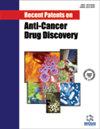SSPH I, A Novel Anti-cancer Saponin, Inhibits EMT and Invasion and Migration of NSCLC by Suppressing MAPK/ERK1/2 and PI3K/AKT/mTOR Signaling Pathways
IF 2.5
4区 医学
Q3 ONCOLOGY
Recent patents on anti-cancer drug discovery
Pub Date : 2024-02-02
DOI:10.2174/0115748928283132240103073039
引用次数: 0
Abstract
Background: Saponin of Schizocapsa plantaginea Hance I (SSPH I),a bioactive saponin found in Schizocapsa plantaginea, exhibits significant anti-proliferation and antimetastasis in lung cancer. Objective: To explore the anti-metastatic effects of SSPH I on non-small cell lung cancer (NSCLC) with emphasis on epithelial-mesenchymal transition (EMT) both in vitro and vivo. Methods: The effects of SSPH I at the concentrations of 0, 0.875,1.75, and 3.5 μM on A549 and PC9 lung cancer cells were evaluated using colony formation assay, CCK-8 assay, transwell assay and wound-healing assay. The actin cytoskeleton reorganization of PC9 and A549 cells was detected using the FITC-phalloidin fluorescence staining assay. The proteins related to EMT (N-cadherin, E-cadherin and vimentin), p- PI3K, p- AKT, p- mTOR and p- ERK1/2 were detected by Western blotting. A mouse model of lung cancer metastasis was established by utilizing 95-D cells, and the mice were treated with SSPH I by gavage. Results: The results suggested that SSPH I significantly inhibited the migration and invasion of NSCLC cells under a non-cytotoxic concentration. Furthermore, SSPH I at a non-toxic concentration of 0.875 μM inhibited F-actin cytoskeleton organization. Importantly, attenuation of EMT was observed in A549 cells with upregulation in the expression of epithelial cell marker E-cadherin and downregulation of the mesenchymal cell markers vimentin as well as Ncadherin. Mechanistic studies revealed that SSPH I inhibited MAPK/ERK1/2 and PI3K/AKT/mTOR signaling pathways. Conclusion: SSPH I inhibited EMT, migration, and invasion of NSCLC cells by suppressing MAPK/ERK1/2 and PI3K/AKT/mTOR signaling pathways, suggesting that the natural compound SSPH I could be used for inhibiting metastasis of NSCLC.新型抗癌皂苷 SSPH I 通过抑制 MAPK/ERK1/2 和 PI3K/AKT/mTOR 信号通路,抑制 NSCLC 的 EMT 和侵袭与迁移
背景:五味子皂苷 I(SSPH I)是五味子中发现的一种生物活性皂苷,对肺癌具有显著的抗肿瘤扩散和抗转移作用。研究目的探讨 SSPH I 对非小细胞肺癌(NSCLC)的抗转移作用,重点是上皮-间质转化(EMT)在体外和体内的作用。研究方法使用集落形成试验、CCK-8 试验、透孔试验和伤口愈合试验评估了浓度为 0、0.875、1.75 和 3.5 μM 的 SSPH I 对 A549 和 PC9 肺癌细胞的影响。PC9 和 A549 细胞的肌动蛋白细胞骨架重组是通过 FITC-花青素荧光染色法检测的。用 Western 印迹法检测了与 EMT 相关的蛋白(N-钙粘连蛋白、E-钙粘连蛋白和波形蛋白)、p- PI3K、p- AKT、p- mTOR 和 p- ERK1/2。利用 95-D 细胞建立了肺癌转移小鼠模型,并给小鼠灌胃 SSPH I 治疗。结果表明结果表明,在无毒性浓度下,SSPH I 能显著抑制 NSCLC 细胞的迁移和侵袭。此外,无毒浓度为 0.875 μM 的 SSPH I 可抑制 F-肌动蛋白细胞骨架组织。重要的是,在 A549 细胞中观察到 EMT 的减弱,上皮细胞标记 E-cadherin 表达上调,间质细胞标记波形蛋白和 Ncadherin 表达下调。机理研究显示,SSPH I 可抑制 MAPK/ERK1/2 和 PI3K/AKT/mTOR 信号通路。结论SSPH I通过抑制MAPK/ERK1/2和PI3K/AKT/mTOR信号通路,抑制了NSCLC细胞的EMT、迁移和侵袭,表明天然化合物SSPH I可用于抑制NSCLC的转移。
本文章由计算机程序翻译,如有差异,请以英文原文为准。
求助全文
约1分钟内获得全文
求助全文
来源期刊
CiteScore
4.50
自引率
7.10%
发文量
55
审稿时长
3 months
期刊介绍:
Aims & Scope
Recent Patents on Anti-Cancer Drug Discovery publishes review and research articles that reflect or deal with studies in relation to a patent, application of reported patents in a study, discussion of comparison of results regarding application of a given patent, etc., and also guest edited thematic issues on recent patents in the field of anti-cancer drug discovery e.g. on novel bioactive compounds, analogs, targets & predictive biomarkers & drug efficacy biomarkers. The journal also publishes book reviews of eBooks and books on anti-cancer drug discovery. A selection of important and recent patents on anti-cancer drug discovery is also included in the journal. The journal is essential reading for all researchers involved in anti-cancer drug design and discovery. The journal also covers recent research (where patents have been registered) in fast emerging therapeutic areas/targets & therapeutic agents related to anti-cancer drug discovery.

 求助内容:
求助内容: 应助结果提醒方式:
应助结果提醒方式:


